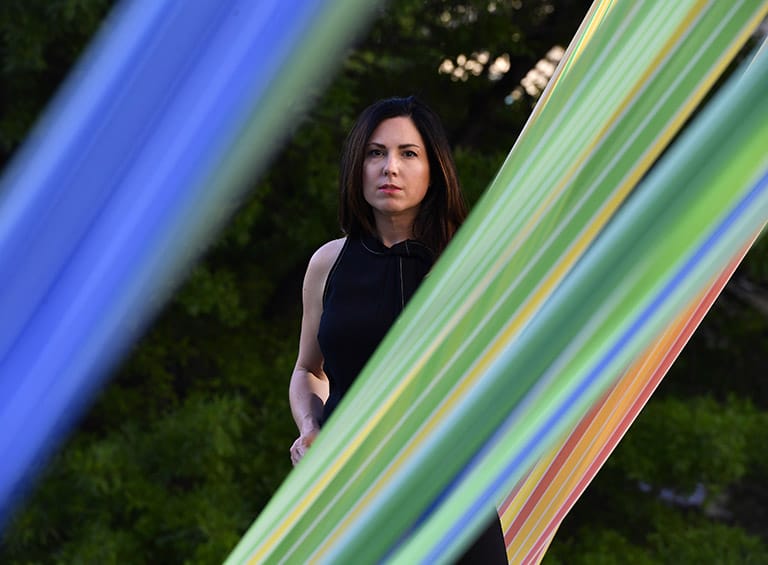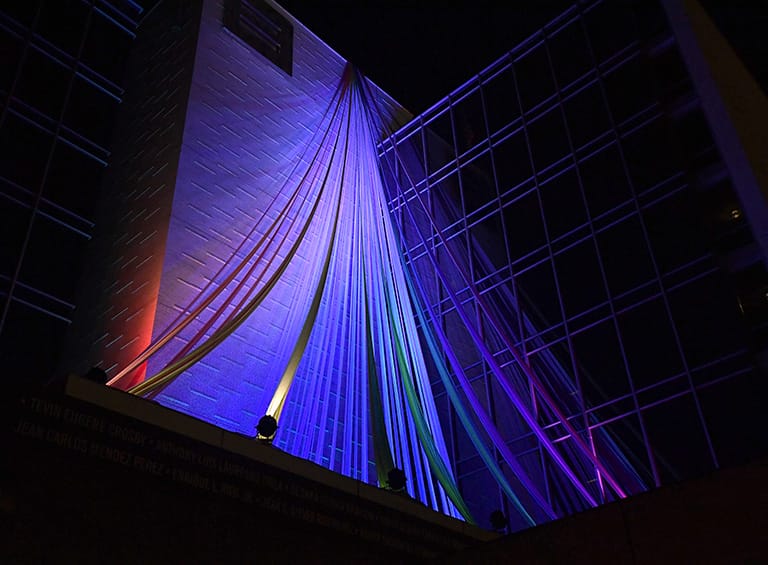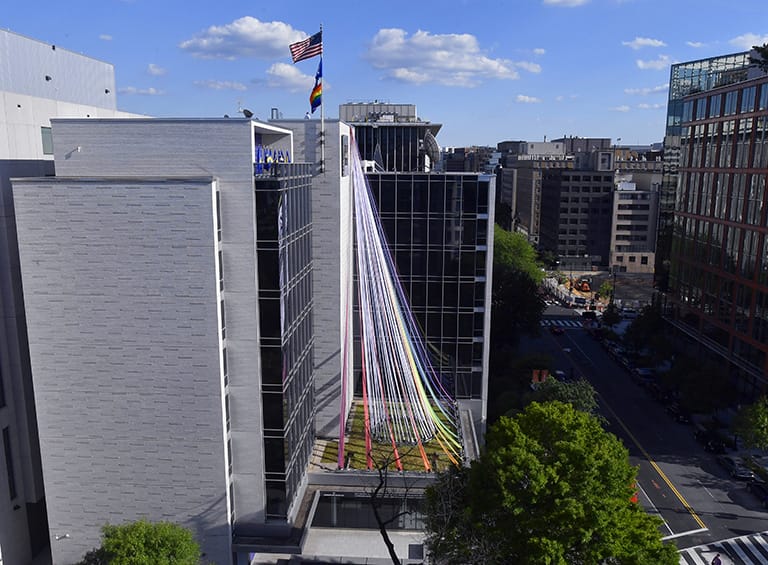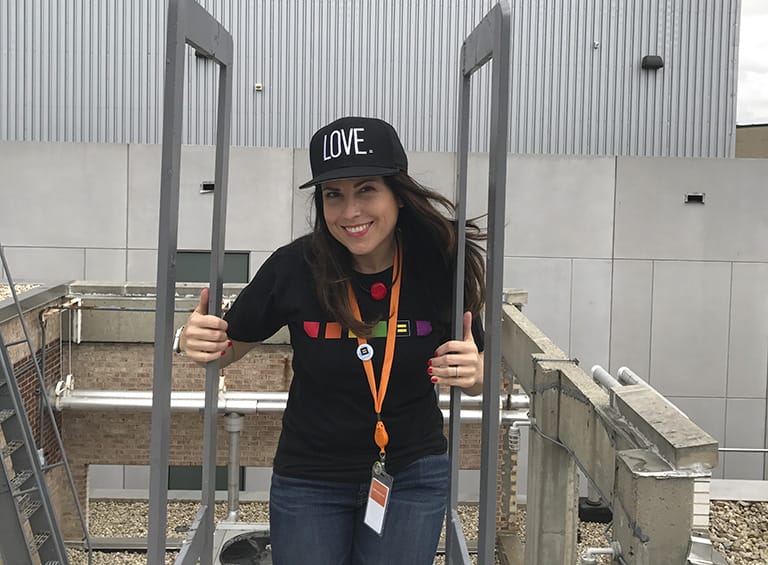Beyond the Rainbow: Artist Megan Geckler’s Colorful Commemoration

The triangular part symbolized strength. The circular portion stood for unity. And each fluttering white ribbon—49 in all—represented a life lost.
Surrounded by rainbow colors and taking shape more than 100 feet above the heart of the nation’s capital, it was intended as a bold statement.
Installation artist Megan Geckler’s large-scale, site-specific projects have tended to lean toward the playful and psychedelic. But a recent commission for a national civil rights organization posed an interesting challenge: How to capture the joyous spirit of Capital Pride, one of the largest LGBTQ pride events in the country, while commemorating the victims of the deadliest incidence of violence against gay people in US history—the June 12, 2016, shooting at Florida’s Pulse nightclub.
Loading...
“Conceptually, attempting to somehow balance the mass killing that happened at Pulse with Pride seemed impossible,” Geckler said.
But after the CGU alumna (MFA, ’01) had a vision of a “pyramid of strength,” she knew what she wanted to create.
Tape Player
The Los Angeles-based artist has spent the last 17 years creating massive, mind-bending installations within architectural spaces. She mostly employs unconventional materials such as rope, ribbon-like streams of fabric, and—a signature feature—colorful strips of non-adhesive flagging tape that is normally used by surveyors and at construction sites.
She’s used as much as nine miles of tape in a single project.
Geckler wants viewers to experience an immediate and immersive change in their environment.

“In the particular moment when someone encounters one of my large-scale installations, they very often fall silent,” she said. “[They] usually stop dead in their tracks, and respond after a few seconds with something along the lines of ‘Whoa,’ ‘Wow,’ or ‘WTF.’”
Utilizing computer-aided design software, an array of mathematical and geometric calculations, and help from volunteers or staff, Geckler has created stunning artworks in a variety of venues: museums, galleries, institutions, and public spaces.
“While the challenges of each of these types of spaces vary greatly, I enjoy being challenged,” she said. “And I have broadened my skill set and approach with each and every project.”
Addictive Art
For the Los Angeles International Airport (LAX), Geckler arranged 21,000 feet of custom-dyed cotton rope in a dizzying display to create We’ve got to cross this great big world somehow. The installation—on view through June 2018—takes the form of a diptych of twin alcoves on either side of pedestrian walkways to form three X shapes to reference the idea that X marks the spot, or the arrival and departure points of travelers.
In Sydney, Australia, she created A million things that make your head spin, a six-story-high kaleidoscopic construction within the atrium of the Customs House, a historic government building that currently serves as a cultural center.
Her installations’ manipulations of space and perspective encourage viewers to enter and observe her art from within.
“The viewer has experienced an immediate and immersive change in their environment,” she explained. “They have become a participant, allowing the artwork to completely transport them into a new environment and state of mind.”
“This is a very powerful thing to be able to accomplish with a piece of art. Frankly, it’s addictive.”
Geckler’s installations have garnered wide attention from domestic and international media outlets and publications including Fabrik, the Washington Post, the Huffington Post, LA Weekly, and the Daily Telegraph. She was featured in the August 2017 issue of O, The Oprah Magazine for its “Women Who Make Beautiful Things” section, which showcased A million things that make your head spin and her 2006 Fill it up and pour it down the inside at the Torrance Art Museum.
A Celebration and a Memorial
When the Washington DC-based Human Rights Campaign, the nation’s largest LGBTQ civil rights organization, contacted Geckler this year for a special commission, she was “honored and very moved.” The nonprofit works to improve the lives of LGBTQ people by advocating for equal rights around the world.

Geckler’s commission was timed with this past June’s 42nd annual Capital Pride festival. But the concept also called for memorializing the victims of one of the deadliest mass shootings in modern United States history.
On June 12, 2016, 49 people were killed and more than 50 wounded after New York-born Omar Mateen opened fire at a popular gay nightclub in Orlando, Florida. It is considered both a hate crime—the worst attack against LGBTQ individuals in American history—and a terrorist act due to the gunman’s proclaimed allegiance to ISIS.
Referencing the number of victims, the installation was named 49.
“I find it reprehensible that LGBTQ people still do not have the same rights and comforts living their lives both in America and globally,” Geckler said. “I believe that we must come together to defeat the hate and bigotry that motivated the attack in Orlando, and others like it.”
Because of the commission’s celebratory and sobering themes, she considered it a unique challenge. But once Geckler saw the Human Rights Campaign building, she knew what she wanted to create.
“The building was perfect for the ‘pyramid of strength’,” she said. “The challenge was how to represent the 49 lives that were lost.”
Stand Together
Geckler used custom-printed flag material to create the installation’s two parts; the multicolored, pyramidal exterior and an interior element with a circular base. The pyramidal element “symbolized the strength of the LGBTQ community,” Geckler said.
The interior was comprised of 49 six-inch-wide strips—representing the victims of the Pulse shooting—that come together in the circular base, representing unity.
“I wanted to stay true to the pride flag, a symbol of strength and celebration for the LGBTQ community,” she said.
In addition, a special LED light show was added—that included 49 seconds of white light—to add layers of meaning.
“I wanted 49 to function as a place for people to process what happened at Pulse and heal, as well as provide a beacon of hope and strength for the community,” Geckler said.

She also created two smaller installations for the Human Rights Campaign: United we stand and Music makes motion, moves like a maze.
49 is Geckler’s first installation centered around LGBTQ rights.
“It is also a call for us all to stand together against hate and violence, create safe spaces within our communities, and find ways to make a difference by honoring the victims with action,” she said.